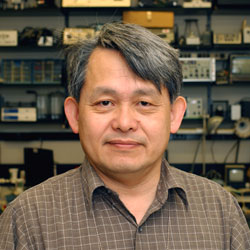| |
| |
| Kuni H. Iwasa, Ph.D., Senior Investigator |
 |
Dr. Iwasa received his B.S. from Osaka City University and his Ph.D. from Nagoya University, where he worked on statistical thermodynamics involving charged biopolymers. He continued his work at Dalhousie University, Indiana University, University of Ljubljana, and Rice University. He came to NIMH in 1979 as a senior staff fellow, and studied motile responses of neurons with Dr. I. Tasaki. At NINDS he worked on single channel kinetics of sodium channels with Dr. G. Ehrenstein and started to work on electromechanical transduction processes in hair cells. He moved to NIDCD in 1991 is currently a Senior Investigator. Dr. Iwasa's laboratory is studying ion channels and the motor mechanism in hair cells.
|

|
Staff:
Research Interests:
The outer hair cell, one of the two mechanoreceptor cells in the cochlea, is a critical element for the frequency specificity and wide dynamic range of the mammalian ear. It has been widely assumed that the motility of this cell is responsible for these functions. Because this cell can respond to mechanical stimuli by creating force, it can modulate vibrations in the inner ear.
We have been testing our hypothesis called the ``area motor model'' that proposes that the hair cell motor has an electric charge that is
transferable across the membrane and that this charge transfer is coupled with changes in the area of the membrane motor. Such a mechanism resembles piezoelectricity in directly converting electrical into mechanical energy. We found that this model is equivalent to a special class of piezoelectricity, one in which a small number of states produces prominent nonlinearities.
These studies show that the outer hair cell is very effective in exerting force for voltage oscillations. We are currently studying whether voltage oscillations are supported at the high frequencies at which this cell operates. These efforts should identify physical principles involved in the ear and further clarify the biological role of outer hair cells.
|
Selected Recent Publications:
Ospeck M, Dong XX, Iwasa KH (2003) Limiting frequency of the cochlear amplifier based on electromotility of outer hair cells, Biophys J 84, 739-749.
Dong XX, Ospeck M, and Iwasa KH (2002) Piezoelectric reciprocal relationship of the membrane motor in the cochlear outer hair cell, Biophys J 82.
Iwasa KH (2001) A Two-State Piezoelectric Model for Outer Hair Cell Motility, Biophys. J..
All Selected Publications
Contact Information:
Dr. Kuni H. Iwasa
Biophysics Section
Laboratory of Cell Biology, NIDCD
Building 50, Room 4152
Bethesda, MD 20892-4162
Telephone: (301) 496-3987 (office),
(301) 480-0827 (fax)
Email: iwasa@nih.gov
|
|















